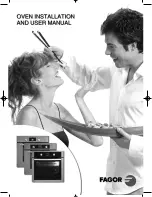
14
Cleaning and Maintenance
INITIAL CLEANING:
Prior to operating your new oven, thoroughly wash the exterior with a mild detergent or soap
solution. Do not use abrasive cleaners, since this might damage the cabinet finish. If the stainless
steel surfaces become discolored, scrub by rubbing only in the direction of the finished grain.
When the oven is first heated, it will smoke until oil used in manufacturing, preservation and dust
from storage and shipping are burned off. An hour at "max." on all burners is usually sufficient.
DAILY CLEANING:
Remove, empty, and clean grease drawers and dirt trays.
Clean griddle drain chutes.
VENT SYSTEM
At least twice a year the unit venting system should be examined and cleaned.
Following daily and periodic maintenance procedures will enhance long life for your equipment. Climatic
conditions (such as salt air) may require more thorough and frequent cleaning or the life of the
equipment could be adversely affected.
STAINLESS STEEL SURFACES
1.
To remove normal dirt, grease and product residue from stainless steel that operates at LOW temperature,
use ordinary soap and water (with or without detergent) applied with a sponge or cloth. Dry thoroughly with
a clean cloth.
2.
To remove grease and food splatter, or condensed vapors, that have BAKED on the equipment, apply
cleanser to a damp cloth or sponge and rub cleanser on the mental in the direction of the polishing lines will
not mar the finish of the stainless steel. NEVER RUB WITH A CIRCULAR MOTION. Soil and burnt deposits
which do not respond to the above procedure can usually be removed by rubbing the surface with SCOTCH-
BERITE sourcing pads or STAINLESS sourcing pads. DO NOT USE ORDINARY STEEL WOOL, as any particles
left on the surface will rust and further spoil the appearance of the finish. NEVER USE A WIRE BRUSH,
STEEL SOURCING PADS (EXCEPT STAINLESS), SCRAPPER, FILE OR OTHER STEEL TOOLS. Surfaces which
are marred collect dirt more rapidly and become more difficult to clean. Marring also increases the possibility
of corrosive attack. Refinishing may then be required.
To remove heat tint- Darkened areas sometimes appear on stainless steel surfaces where the area has
been subjected to excessive heat. These darkened areas are caused by thickening of the protective surface
of the stainless steel and are not harmful. Heat tint can normally be removed by the foregoing, but tint
which does not respond to this procedure calls for a vigorous scouring in the direction of the polish lines,
using SCOTCH-BRITE sourcing pads or a STANILESS sourcing pad in combination with a powered cleanser.
Heat tint action may be lessened by not applying, or by reducing heat to equipment during slack periods.
BURNERS- GENERAL
Little attention is needed, but if spillage should occur, it may be necessary to clean around pilot areas, air
mixer and under burners. Use a wire brush if necessary.
Periodically, burners (particularly open top type) should be removed and cleaned. Allow interior to drain. Dry
thoroughly before replacing.
HOT TOPS
Allow range to cool. If water is used on tops while still hot, they may crack. Avoid this practice. Remove tops
from range and clean surfaces with hot water and detergent. A wire brush may be used on the underside of
the hot pot plate. It is recommended not to clean tops while still on range, even if cooled, as excessive
water will drip into the burner box and deteriorate the metal.
Summary of Contents for TR-0-G24F
Page 26: ...Explosion drawing 25...
Page 31: ......
















































